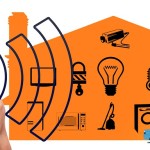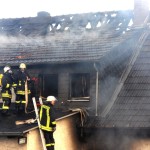Video Surveillance Troubleshooting
Problems that may arise with security camera systems are sometimes related to powering issues or even factory defects. However, more often than not, these problems are usually attributed to improper cabling and connections, which boils down to the installation.
Prior to security camera system installation, technicians must be mindful of the features, functions, and especially the limitations of the actual hardware. While all installations are different, an understanding of the specific system and the customer’s expectation is crucial for a quality job.
Here are some common installation problems you may come across along with helpful trouble shooting tips.
Rolling Lines On The Screen
Whether they are white or multi-colored, these rolling lines or ghosting over the camera’s video are often caused by video cables that run close to high-voltage power sources.
To prevent this, cameras should be tested at another location prior to installation in order to eliminate any hardware defects as a cause to any future issues. Also, keep wires away from sources that supply high-voltage electrical charges at any point of the run. Improperly grounded electrical circuits can also cause video disturbances, which is why high quality camera cables are crucial.
Infrared Glare/”White Out”
The most common causes of IR glare are reflective surfaces and large, lightly colored areas. “White out” (unrecognizable white silhouettes on screen) is often caused by objects that are too close to the camera. Also, if you install infrared security cameras under eaves, the beams of the IR LEDs may hit parts of the structure and bounce back, causing the reflection to blind the camera.
To combat these potential problems, install your cameras in areas clear of any objects that may cause glare or obstruct the camera’s view. Also, be sure that the user keeps these areas clear (at least three feet). You should also test daytime and low-light conditions before completing installation. Cameras with “Smart IRs” that have dynamic IR strengths can help to alleviate these problems as well and ensure high-quality night time images.
IR Cameras Unable To See In The Dark
In order to employ IR cameras properly, a surface is necessary for the IP light beams to bounce off. For example, when you point a flashlight into the night sky it remains dark because there is nothing allowing the light beams to bounce back.
Choose cameras that have sufficient IR distance capabilities. During installation, point the cameras at an angle facing a surface (ex. ground, wall) and test them under low-light conditions before proceeding.
Extreme Glare During Daylight
If your property has lots of glass doors and windows, you may have an issue with extreme glare. Glare from the sun does not mix well with security cameras, which means a special alternative is necessary.
In these situations, you want to invest in cameras with mechanical Wide Dynamic Range (WDR). These are designed to prevail in extreme lighting conditions. While “digital WDR” does it exist and can be helpful in these situations, it does not work as well as true, mechanical WDR.
Insufficient Power Causing Cameras To Drop Out
Without the proper power source, security cameras will not perform properly, causing them to drop out or lose power. While spec sheets may specify the camera’s power needs, they may not factor in the added power necessary for IR/low-light applications. For example, the system may work fine during the day, but drop out at night when the IR kicks in.
It is advised that you use a power supply which supports twice the voltage requirements of all your cameras combined.
When it comes to power, distance may play a role as well. Voltage drops can occur due to poor quality cables and long distances. To avoid this issue, AC voltage is recommended for runs greater than 250ft.
Inadequate Coverage
With great features and functions come limitations as well. For maximum coverage of your property, first map out your installation to identify areas that need surveillance. Based on the locations, you can determine which specific features you need for certain areas. For example, focal lengths and angles of view should be considered (longer lenses for closer view, shorter lenses for wide-angle shots). In general, license plate cameras should be installed no more than five feet from vehicles and valuable points of interest (such as cash registers, entrances and exits) should have a camera dedicated solely to monitoring that area.
Have you come across any issues not mentioned here? How did you resolve it? Share your stories and advice with us on Facebook, Google+, Twitter, LinkedIn, and Pinterest.
Choose SecurityCamExpert.com for quality security cameras along with professional installation and support services. Visit us online or call 888-203-6294 to learn more!
Building A Smart Home
Smart Homes have quickly transitioned from a novelty idea to reality. With more smart products on the market than ever before, most consumers are investing in this new technology to keep their homes and loved ones safe.
If you are considering transforming your living space into a smart home, you may want to start slowly as the process can be quite overwhelming. Follow these steps to ease your way into turning your smart home dream into reality.
Pick A Room
Your first step should be choosing one room. As with any process, it is easier to break your ultimate goal down into smaller steps, making the project a little less intimidating. By tackling one room at a time, you are allowing yourself the ability to see what works best for you and perfecting it before moving on.
Room Inspiration
Let the room guide you toward which function you should attempt to automate first. For example, in a living room, you could begin with a smart speaker, or in a bedroom, maybe begin with lighting. What automated function would be most convenient or the top priority for you?
Solve A Problem
For a smart home that really serves a purpose, try solving a problem within your home. Is there an aspect in your daily life that could be improved with automation? For example, a smart garage door opener can provide keyless entry for your kids and can alert you when the door has mistakenly been left open. By tackling these problems, you create smart solutions that truly benefit you.
Smart Solutions
Let your smart devices provide smart solutions. If you’re worried about home security, use security cameras with motion sensors and push notifications, or invest in a smart lock in case of forgotten or lost keys. Home automation should help put your worries at ease.
Pick A Product
Once you’ve decided on a function you would like to automate, you need to pick a product. Don’t just choose one based on hearsay, choose a product you find will benefit your smart home.
If your budget limits you to one product, experts recommend starting with a smart speaker. This will give you a sense of how to interact with smart devices as well as set the tone for the ecosystem that controls your entire smart home.
Starter Pack
What would make your transition to a smart home even easier? A starter pack filled with the essentials. Amazon and Nest smart home products are compatible with a wide range of other smart home products and devices (they will often be marked clearly with which system they are compatible with), allowing you to build from there.
Do you have a smart home? Share your tips, tricks and advice with us on Facebook, Google+, Twitter, LinkedIn, and Pinterest.
For home and business security solutions, visit SecurityCamExpert.com. To learn more about our products, inquire about installation services, or request a free* site survey, please call 888-203-6294.
Prevent Home Accidents
When it comes to home safety, it is easy to overlook some potential hazards which can cause serious and sometimes fatal accidents. Luckily, some of these can be prevented with simple and relatively cost-effective measures. Take action and prevent these mishaps with these tips.
Alarms
With the surprising number of deaths resulting from fires in homes/buildings with absent or non-functioning smoke alarms (an average of 1450 deaths from 2009-2013), please make sure that you have working smoke alarms on every level of your home (including the attic and the basement).
To ensure that all fires are detected, invest in one which utilizes both a photoelectric sensor for smoldering fires, and an ionization sensor for fast-flaming fires. Those alarms with an ionization sensor should be kept away from the kitchen and baths. Also, invest in interconnected alarms so that if a fire starts in one area of your home, the entire home is alerted.
If your house has a gas dryer, range, other fuel burning equipment, or an attached garage, it is advised to install a carbon monoxide (CO) alarm. These should be present on each living level, as well as in the basement and near the garage (follow manufacturer’s instructions on placement).
Test your alarms at least monthly, and vacuum them to prevent dust from interfering with their sensors every so often. Follow the guidelines on when to replace batteries and the devices themselves based on life expectancy of sensors.
Trips & Falls
Did you know that every year, more than 10,000 people die after falling at home? Even more sustain injuries. We all can be a little clumsy sometimes, but there are ways to prevent these types of accidents in your home.
Make sure that your furniture is arranged in a way that does not disrupt your typical routine (ex. a clear path between your bed and your bedroom door). Keep any pet bowls and electrical cords along the walls rather than across any pathways. Avoid storing piles of paper on the ground, and eliminate any throw rugs as they may skid. If you decide to keep the throw rug, use carpet tacks or double-sided carpet tape to keep it in place. In the bath tub, consider installing a rubber mat or non slip strips and grab bars. Lastly, if you’re remodeling, you may want to choose anti-slip flooring material whenever possible.
Burns
According to the National Safety Council, an estimated 486,000 people were treated for burn injuries (many were children) in the United States in 2011. While lowering the maximum temperature on your water heater to 120°F can help prevent scalds, it also provides an ideal environment for opportunistic bacteria to breed.
Instead, set domestic water heaters to 140°F and employ anti-scald devices at each faucet. For example, thermostatic mixing valves mix hot and cold water to a safe temperature before sending through the faucet. These have become increasingly common in new homes and are often built in to newer fixtures. A licensed plumber can examine your system and install them as needed, or you can save money by installing a single anti-scald valve for your entire house.
Do you have any other home safety tips to share? Connect with us on Facebook, Google+, Twitter, LinkedIn, and Pinterest.
Secure your home with our quality security camera systems today! Browse online at SecurityCamExpert.com or call 888-203-6294 to schedule a site survey or learn more about our products and installation services.
California Surveillance Laws
When it comes to surveillance, there is a fine line between privacy and public safety. Because of this, surveillance laws are often scrutinized by both sides. A new bill was introduced at the end of 2016 which requires any local law enforcement agency in California that uses surveillance technology to submit a plan to local officials on how it uses equipment and information collected. This would need to include surveillance plans for any facial recognition software, drones, and even social media monitoring, and would be presented at an open hearing.
While this disclosure from law enforcement may put some worries at ease, others may want more. Privacy advocates believe that this is still not enough to cover spying equipment and technology that is continuing to evolve and expand. On the other side, law enforcement officials argue that creating plans and policies for each device may be unfeasible and interfere with investigations.
But state Senator Jerry Hill (D-San Mateo) says that it was introduced “to create transparency and a check and balance.” Without regulations on these devices and technology, they can easily be abused and infringe on our privacy rights.
With fairly comprehensive digital privacy laws, California has been actively working toward disclosure when it comes to law enforcement surveillance. State laws require a probable cause warrant for access to digital content and devices (ex. cell phones) and law enforcement must catalog information and make it publicly available.
The new bill gives agencies until July 1, 2018 to draft policies detailing all the types of surveillance technology used and the authorized reasons for using them, along with the types of data collected, who can access them, and a description of their training. It also prohibits an agency from acquiring new technology unless approved by local officials at a regularly scheduled public meeting.
Last year, two surveillance laws went into effect, one of which requires to draft and publicly post privacy and usage policies for operating automated license-plate recognition software. The other requires the same for the use of cell-site simulators (“Stingrays” or “Dirtboxes”). These are powerful tracking devices that function as fake cellphone towers to collect information. However, their ability to collect information from innocent people not under investigation has sparked outrage and court battles.
Despite current surveillance laws, privacy advocates believe that not all agencies are complying and that not enough is being done to ensure that they do. To evade the disclosure requirements, agencies could borrow technology from other federal agencies, which is not subject to state law.
In an effort to check compliance, the Electronic Frontier Foundation and other nonprofits and watchdog groups searched through numerous California government websites to make sure surveillance policies were posted. While many were easily located, policies for at least 90 agencies (which, based on public records, were believed to use surveillance technology) could not be found. Since this task in April 2016, more agencies have posted their policies online.
While the new bill is meant to be inclusive and comprehensive, concerns remain. Some worry that criminals may figure out how they are being tracked, others bring up issues of time sensitivity when it comes to buying or borrowing new technology, and privacy advocates are still skeptical about the cost, risks, and enforcement.
There are obviously mixed feelings about this new bill, and other surveillance laws. What are your views? Share your thoughts and opinions with us on Facebook, Google+, Twitter, LinkedIn, and Pinterest.
Keep an eye on your home or business with quality CCTV surveillance systems. Find a great selection at SecurityCamExpert.com or call 888-203-6294 to speak with a representative.



